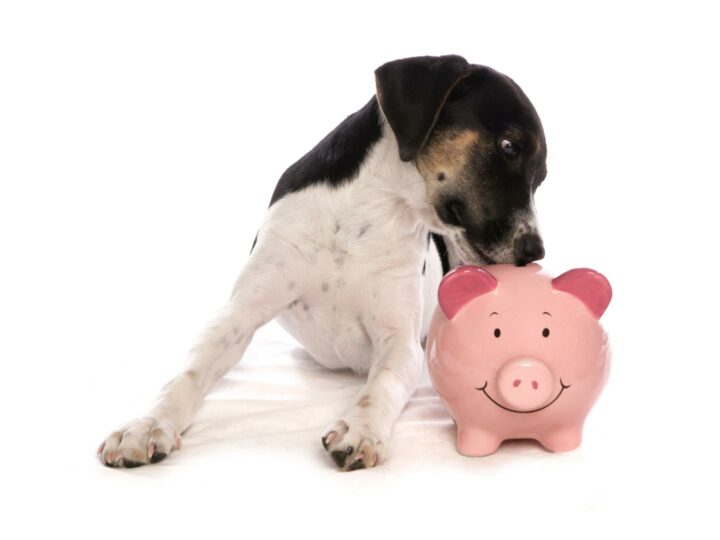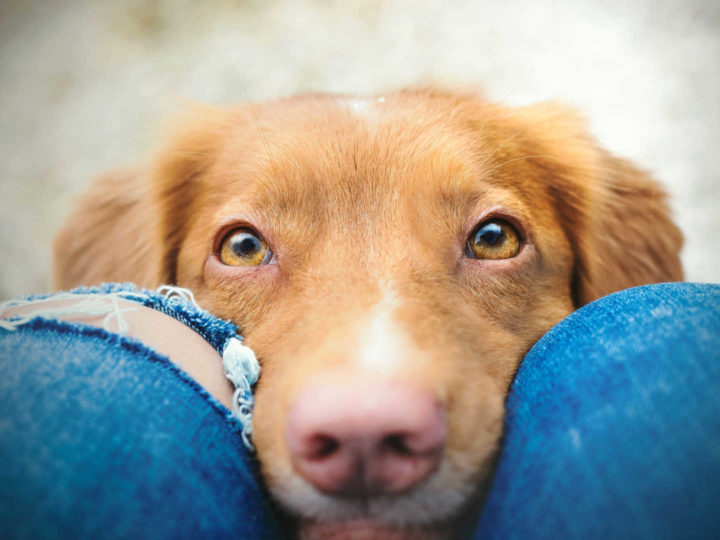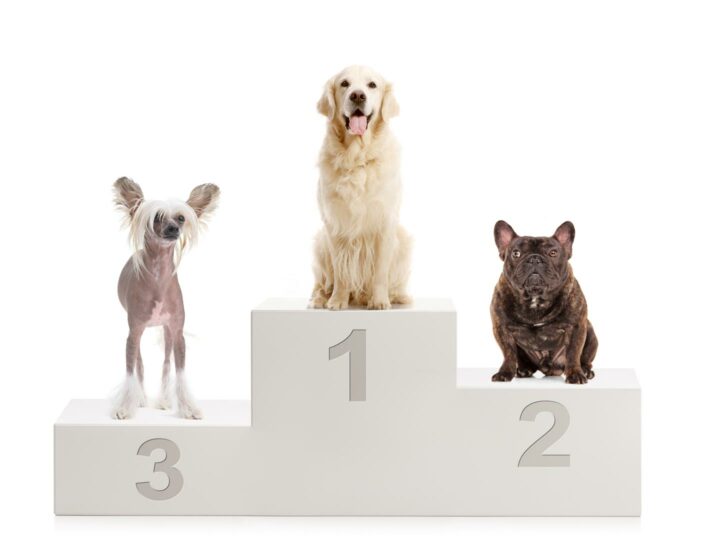- Understanding dog language to improve your affinity
- How to interpret dog language
- Dog language: a typical example
- Dog language when he gets close
- Why do dogs wag their tails when they see their caretakers?
- What does it mean when dogs lick us?
- Why do dogs lay on their back?
- What does it mean when dogs sit? And what about when they sit on you or on your feet?
- What do dogs want to tell us when they cry?
- What do dogs want to tell us when they look at us?
- Dog language when he runs towards us
- Why do dogs move back?
- Why do dogs “shake off”?
- What does it mean when he puts his ears up straight?
- Dog language when he goes down with his front legs only
- Why do dogs yawn?
- Dog language in everyday life
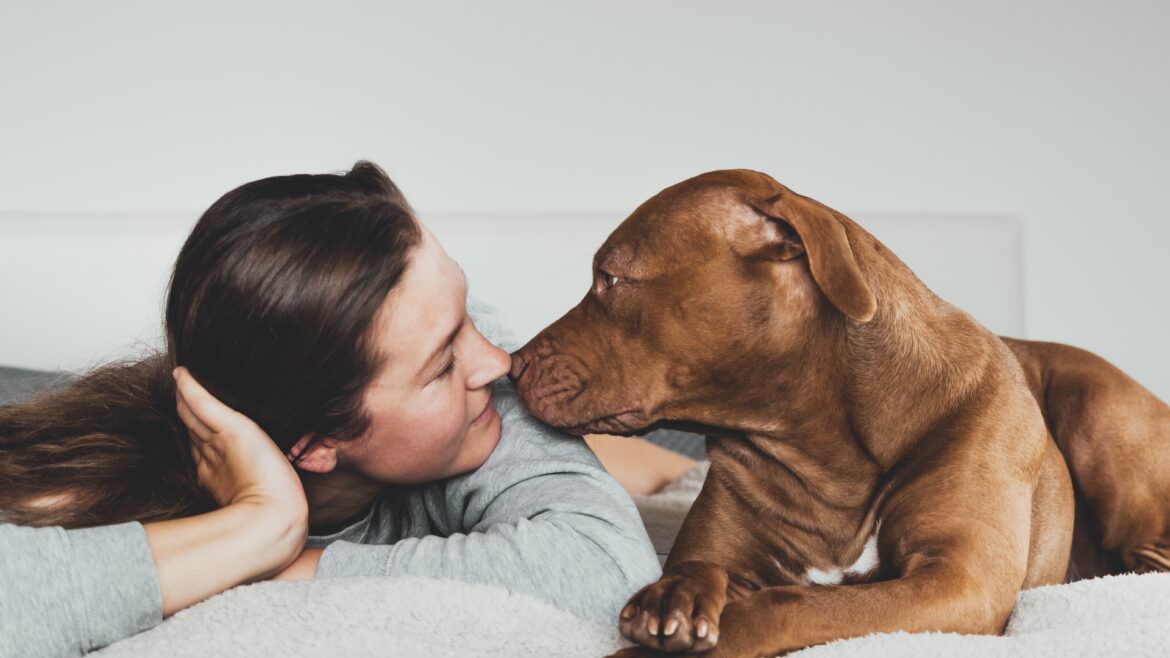
Today we talk about communication! The topic is actually how to interpret positions and gestures of our four-legged friends
Understanding dog language to improve your affinity
Dog language is unique, it belongs to them and they use it to communicate both with their peers and with humans.
This may seem like an apparently simple statement, but it is instead fundamental if we want to activate a deep affinity with our furry friends, because it pushes us to understand them and, above all, to communicate with them effectively.
The opposite would be impossible, but we can at least engage ourselves in learning dog body language, in order to understand them, to be helpful and to make them happy on many different occasions.
Furthermore, by understanding dog language, we’ll also feel closer in this special relationship with our four-legged heart.
This article is therefore dedicated to understanding the language of dogs and it contains some of the main signals they send us every day, with the consequent interpretation.
There are several sources. We took inspiration from a real ‘best seller’ regarding the language of our four-legged hearts: “On Talking Terms with Dogs: Calming Signals” of the Dog Trainer Turid Rugaas who, in the late 80s, studied and expressed the ‘Calming Signals’ as a fundamental part of the communication system in the social group.
We therefore examined various articles written by expert educators and got information from professionals who helped us, in the best possible way, defining the fundamentals of dog language.
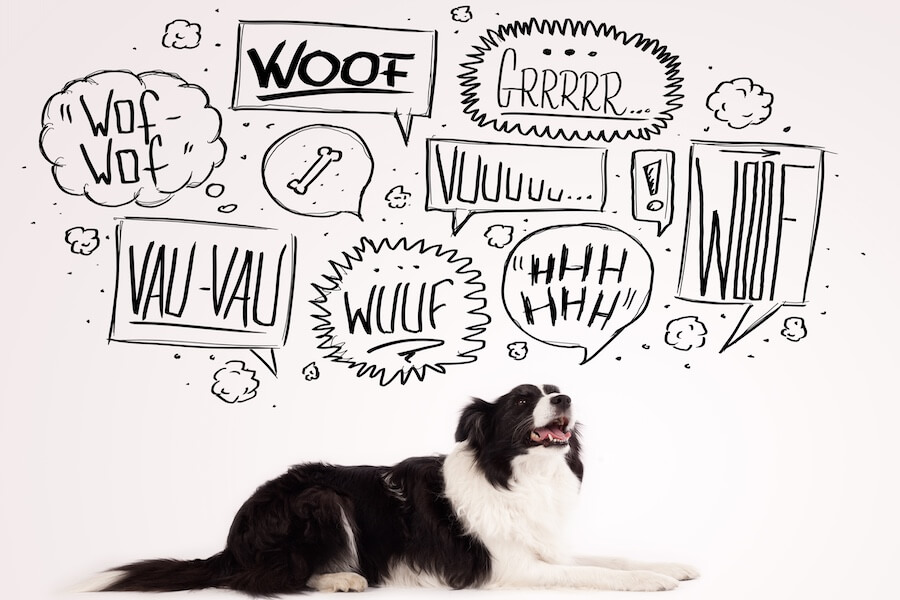
Our four-legged friends communicate in so many different ways, but we can strive to understand dog language.
How to interpret dog language
This ‘super’ question is at the basis of the relationship that every dog parent has with his four-legged friend, because understanding the language of dogs is a very special adventure!
How many times have we wondered (or rather… we asked our furry friend): “Are you ok?”, or “What do you want to tell me?”, “Are you hungry/thirsty/scared/wanna play?”, “Why are you barking in this way? What’s happening?”.
To find the answers, we need to understand how dogs communicate and, in this regard, we start by introducing the expression “non-verbal language”, that is, the extra-linguistic signals such as gestures, postures, facial expressions.
We should keep in mind that this type of language in dogs is voluntary, consciously done to send a message, while in humans it is often involuntary.
For example, we can think of the moment in which we are at a red traffic light, on a two-lane road and a car stops next to us and we instinctively look at the driver but then, to avoid him thinking that we are staring at him, we start to adjust the car rear-view mirror, we focus on the steering wheel or we look away from him and focus on the road.
Well, in this case we probably wouldn’t even noticed that we behaved like that, but in the dog every posture and gesture is taken into consideration and used with a specific purpose.
In this regard, Turid Rugaas introduces the cut-off signals, deriving from the behavior of the dog’s closest ancestor, the wolf. These signals, so-called “interruption“, are aimed at minimizing the possibility of conflict.
According to the Norwegian dog trainer and writer, dogs have their own original language and the ability to communicate with their peers.
These signals, which apparently have the aim of interrupting an aggression, are actually aimed at preventing it, since dogs, like wolves, are animals that do their best to avoid conflicts.
In other words, the purpose of dog language is to solve conflicts in a preventive way.
The problem is that we humans are often the ones who create situations of discord!
Dog language can be codified through signals, which pets daily send us over and over again in order to calm down situations and relationships, so that life peacefully and happily flows for everyone.
Now it’s time to discover them.
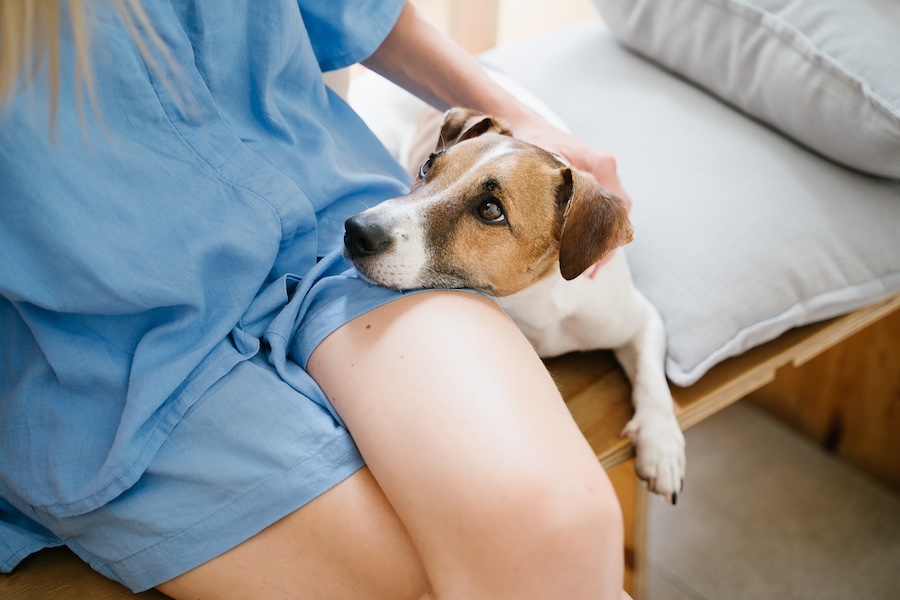
Who knows what he wants to ask with that sweet little face resting on the legs…
Dog language: a typical example
In her book, Turid Rugaas gives the example of a person who wakes up in the morning in a bad mood, because he probably wanted to sleep a little longer, but he has to take his little furry for a walk… (we’re sure it happened to you as well!).
He then looks at him and speaks in a slightly bothered tone, he takes the leash and the pet is definitely joyful! He jumps, runs, barks… but his keeper, with a slightly harsh and annoyed tone, commands him to sit. Then the furry friend yawns before sitting down.
The pet caretaker then yanks him and what does he do? He turns his back and puts his nose on the ground.
The dog keeper let him run free in the park, then calls him, perhaps with a slightly stressed voice and he slowly comes back walking in curve. The keeper thinks he is doing it on purpose to take time (and then gets annoyed), but he smells the ground, makes an even wider curve and looks away…
This simple story contains many examples of signals related to pet language that they send to their human companions in various stages… just to invite them to calm down!
According to Turid Rugaas, there are at least around thirty signals belonging to the dog language, some more obvious, others unnoticeable, which through time, patience and experience can become easier to catch and recognize.
Dog language when he gets close
Dog language when he approaches us, as well as other people and other furry friends, is full of calming signals.
According to Rugaas, fast movements generally have a threatening intention, while slow ones have a calming intention.
If, for example, our pet meets a friend and they both slow down until they stop, this is a ‘peace’ signal, which they do at the same time to release tension, because neither wants to start a fight.
Similarly, if he turns his head quickly, it is a sign of notified threat, but if we (humans) also turn our heads, we can respond using the same language, that is, communicating that we are not a threat to him.
Turning to his side or turning his back are also a strong calming signal and both belong to the dog language.
For this reason, Rugaas recommends turning our backs if a four-legged friend behaves aggressively: barks, growls, but also when he is too excited.
Turning your back will most likely calm him down.
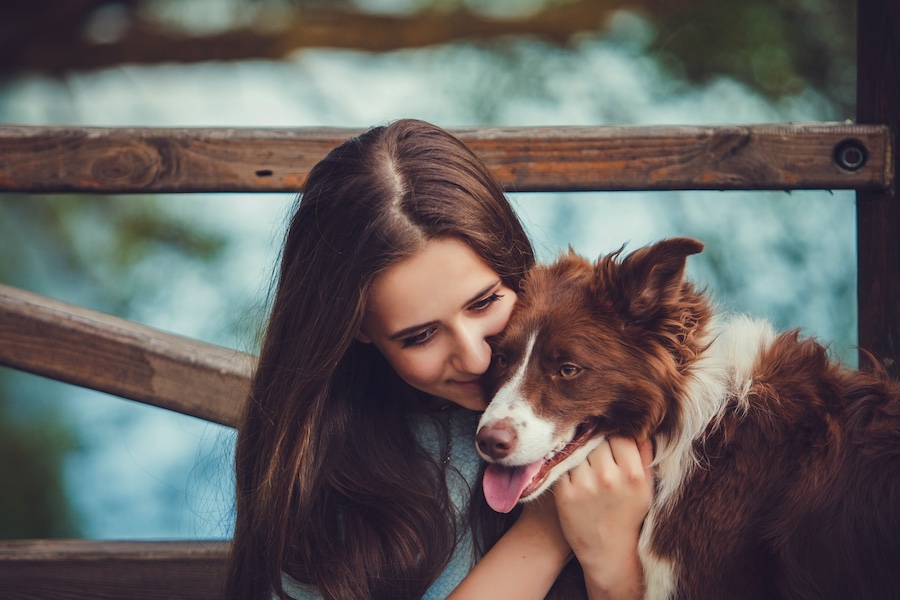
Our little friend gets close, now it’s time to stroke and cuddle him as he deserves.
Why do dogs wag their tails when they see their caretakers?
Tail wags in dogs are adorable and we always interpret them as a great display of happiness and fondness.
In most cases dog language wants to tell us exactly this: lots of love!
But, in many cases, dog tail language can have different meanings, that is to say it could mean something else, especially in cases of tension or in situations of possible danger.
In this case, the pet wags his tail together with other signals that show upset or tension, or even fear, such as whining or howling.
Wagging the tail is always part of their language, it is a calming signal for people and for themselves, a sort of ‘white flag’ that our furry friends raise to ask for universal peace.
In general, the pet wags his tail when he feels:
In generale, il pet scodinzola quando prova:
- Happy: in this case the language can convey excitement because he sees his mate
- Desire for interaction: he invites to interaction and play, communicated through a tail wag with a constant but not too fast pace.
- Anxious: often communicated with a rapid, low tail wag
- Nervous: if the tail is stiff and pointed upwards and moved with short and rapid movements, it can be a sign of threat and, sometimes, even the prelude of an aggression.
The position of the tail is fundamental to understand the language of dogs!
In summary, here are the major forms of language according to tail positions and movement:
- Horizontal tail communicates a feeling of joy or confidence
- Tail tucked between the legs conveys a feeling of fear or discomfort
- Dangling tail means sadness or disgust
- Raised tail can communicate expectation or even anger.
And what does it mean when the dog has his little tail between his legs?
As seen, the tail plays a major role in dog language. When the tail is tucked between the legs, it can signify both surprise and fear.
Factors can be various, from encounters with people or other animals, to an environment that does not convey safety to him.
The pet then puts his tail between his legs to protect the rear area, because as we know, they use to smell each other precisely in this place as an introduction ritual.
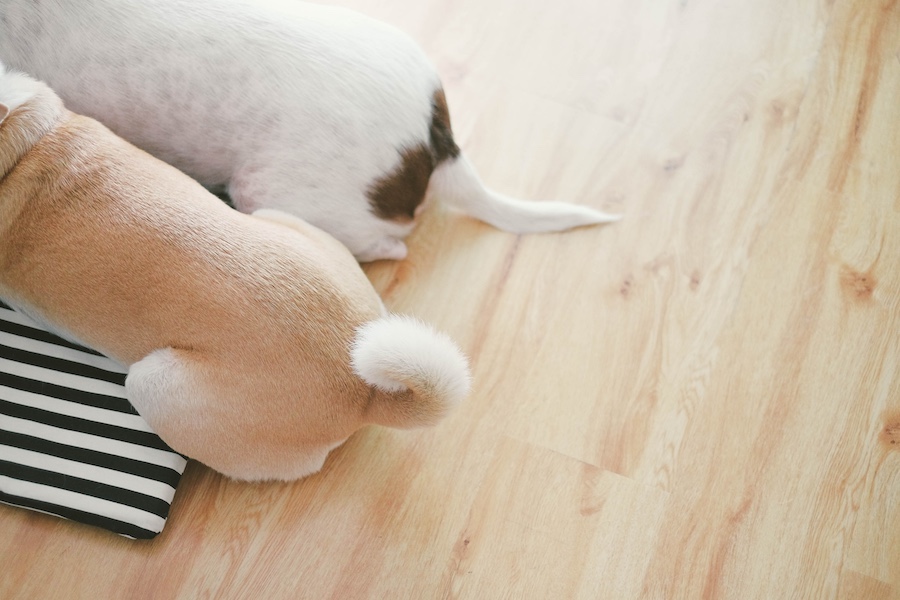
Dogs’ tails can communicate us so many things… we just need to learn their language.
What does it mean when dogs lick us?
How many times have we received an “unexpected kiss”? Or a damp and long face and hands “cleansing”?
Even in this case there is no universal answer since dog language must be codified depending on the situation and on the pet personality.
It is important to consider that dogs use their tongue to ‘taste’, record information and transport it to the brain via the vomeronasal organ.
They do it with everything, from things that seem good to us, such as grass, to those that are not very ‘nice’ for us, such as the secretions of other dogs.
In this case, the vomeronasal organ comes into play and is used by the dog to detect pheromones, chemical factors that transmit information among individuals of the same species.
Pheromones are deposited by other dogs through markings and release a lot of information such as reproductive status, but also any emotional condition.
Licking, for them, is equivalent to discovering, but also taking care of the cleanliness and well-being of themselves and the humans they love.
Dog language, in this case, can show affection and the desire to take care of us, but the furry friend can also lick to seek attention or to interrupt a potentially dangerous situation (and here it becomes a form of language oriented looking for peace, that is to say a calming signal).
If he licks us a lot and continuously, this behavior can become a sort of anti-stress, and in this case it is important to ask for expert advice, while in other cases it can correspond to a kind request to tell us to stop doing something that bothers him or creates discomfort.
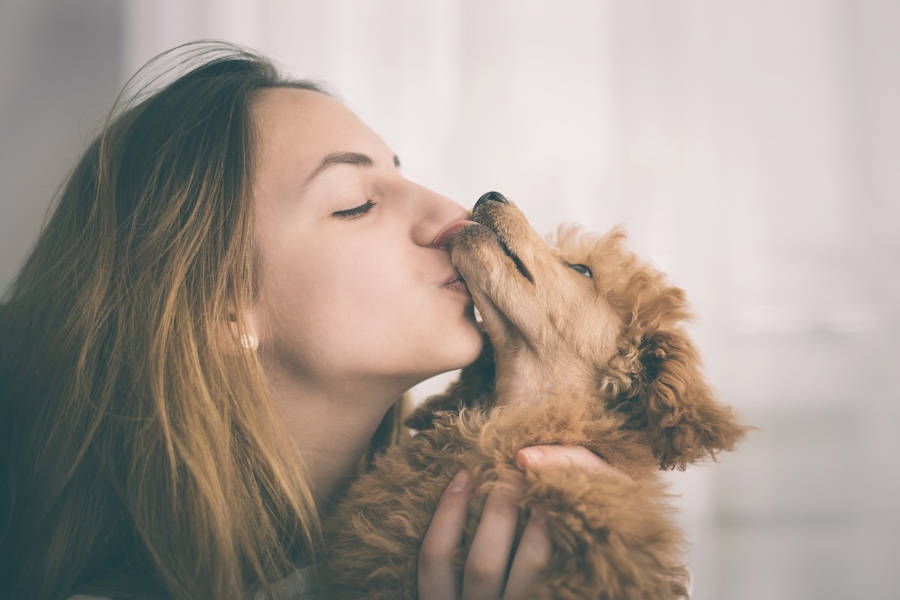
This little dog probably loves giving kisses to his keeper.
Why do dogs lay on their back?
Dog language when they lay on their back is unmistakable: it’s time for belly rubs!
Understanding it as a gesture of submission is also very common and, in both cases, it is a correct interpretation.
On the other hand, when he lays on his stomach, it is a clear calming signal, used above all by high-ranking breeds to bring calm to the pack.

Who wants to rub the belly of this little furry friend?
What does it mean when dogs sit? And what about when they sit on you or on your feet?
Like us humans, dogs sit several times a day. It is often a natural, relaxing and comfortable position for them, but some other times dog language can mean something specific.
If the furry friend sits down during the walk, the reason could be simple tiredness, especially if the ‘trip’ is long-lasting, but this pose can also mean that he wants to change the way, probably because something worries or scares him.
And what does the dog language tell us when he sits on our feet?
This behavior is quite usual and, as happens in other cases, it can have different meanings, based on the context and on the personality of our four-legged heart.
The first reason is that he could be seeking for physical contact: the human’s feet are, in fact, the most ‘comfortable’ parts to reach, and by leaning on them, our little furry friends declare the desire to be close to us.
It is often a relaxing pose, both at home or even outside. In these cases, sitting on the feet may mean a request for contact, but there may be a possessive and territorial motivation, especially on dogs who have this more pronounced nature.
Last but not least, we must consider that in cold seasons the pet may want to sit on our feet to protect himself from the cold of the ground. In this case, dog language communicates affection and also the desire of more comfort.
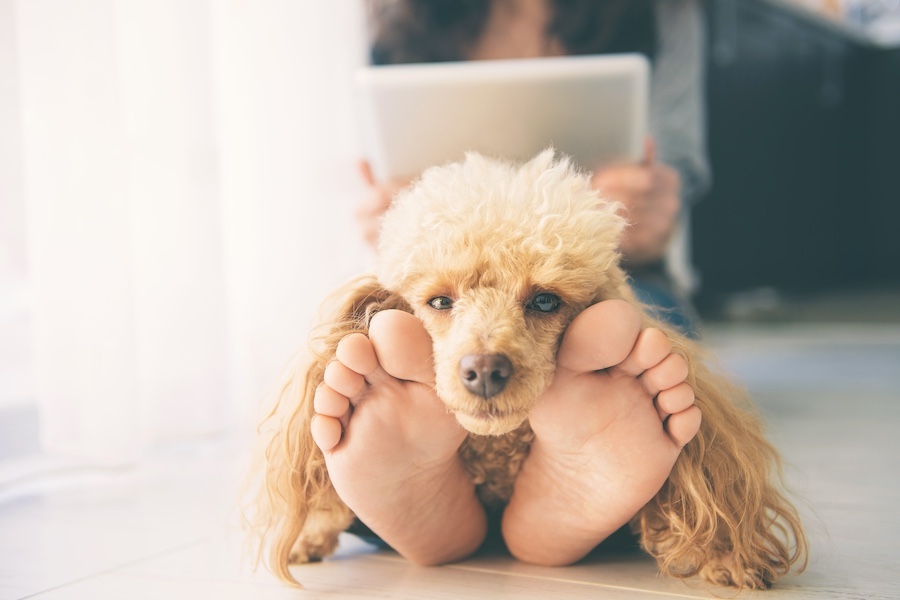
Is this cute poodle resting or maybe he’s seeking for attention?
What do dogs want to tell us when they cry?
Dogs can moan, cry and even howl when they show need, agitation, discomfort and even pain. We therefore reaffirm that, even in this case, the language of dogs deserves attention to be correctly interpreted.
Our little friends can cry even when they are overexcited about playing, so it is important to clearly understand the context in which they cry.
If, for example, the four-legged heart cries at night, he may want to ask us something, perhaps he’s hungry or he wants to do his physical needs. In case he inconsolably cries, he could tell us that he’s afraid of being alone and he needs support and closeness.
What if the dog cries and wags his tail at the same time?
Crying and tail wagging might seem like two apparently separate behaviors and, in this case, it is important to understand the context and also the other signals of dog language.
Crying and wagging at the same time can, in fact, communicate:
- Urgent need for attention
- Excitement due to anxiety
- Discomfort, with a request to be helped and looked after
- Lots of joy, especially when puppies
Also in this case dog language must be codified according to the character of the pet and to the specific situation. It is also important to try observing other signals such as his look.

What does this four-legged heart want to tell us?
What do dogs want to tell us when they look at us?
This is one of the most frequently asked questions about dog language and, as explained by our dog trainer Chiara, who completes and supervises our texts, same behaviors can correspond to different interpretations.
According to the dog trainer Luca Spennacchio, understanding what it means when the pet stares at us depends on the context and on his personality. It can mean affection towards us, a request for attention, but also a request for space or distance.
How is dog language translated in this case?
If the pet has a good relationship with us and with people in general, he may simply want to keep eye contact for longer, in this case he shows us affection.
Looking at the beloved human for a long time releases oxytocin (the so-called love hormone) in both and this happens especially in prolonged looks, even more if there is interaction with strokes and affectionate gestures, as shown by the Azabu University in Japan research published in the Science journal.
But our little friend can stare at us even if he’s looking for attention or waiting for instructions and this is especially true for trained and very collaborative four-legged hearts. In this case, if he is involved in many activities, especially the family ones, this look may want to communicate ‘what are we going to do?’.
At the same time, when he looks at us, it can mean a request, perhaps for food, for attention, for play…
In this case, dog language corresponds to a signal of need, that is, the furry friend is silently telling us what he requires to be happy.
Can the gaze of a dog show anxiety or worry? Yes, in some cases, they may turn to us with a prolonged eye contact also to seek comfort, especially in tense or problematic situations.
A typical example is when he looks at us at vet’s waiting room, a situation that is rarely comfortable and where our friend seeks for our eye contact to find reassurance and comfort.
And when is the gaze threatening? It can depend on various factors and situations and, generally, dog language in this case communicates a request for space and distance, in other words an order to move away. This can be a language of peace, a calming signal, which preventively brings peace to a potentially tense and dangerous situation.
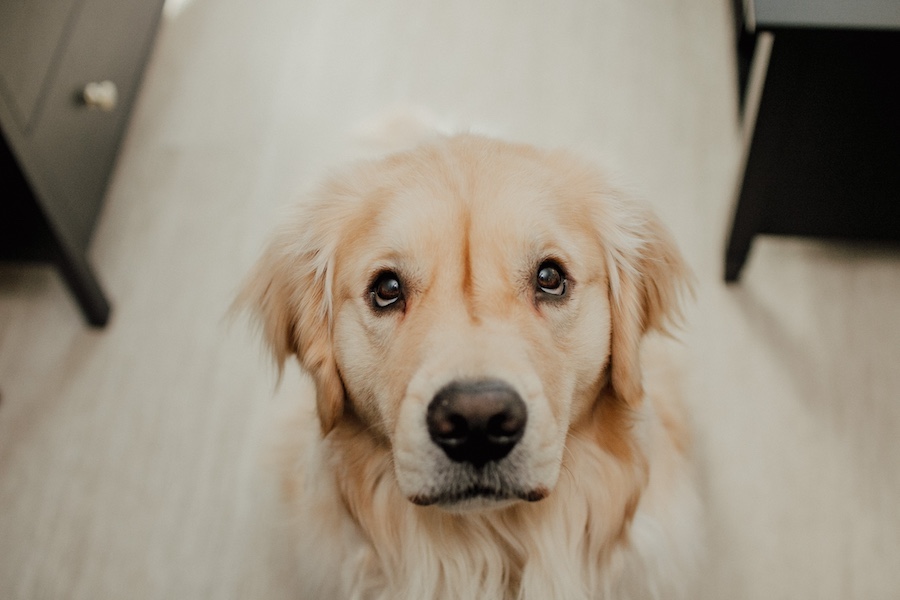
Sometimes one look is worth a thousand woof.
Dog language when he runs towards us
As previously seen, dog language when he runs towards us can have different modalities and, consequently, different meanings. If the four-legged heart runs fast, he may be agitated, both in a positive and negative sense.
It is interesting, in this case, to observe which way he takes. When it is straight, it means trust: he trusts us.
However, when dogs make a curve, it is a defense signal, which they especially use with their peers.
Similarly, a dog that doesn’t know us may make a curve when he comes towards us, because he doesn’t yet trust us and it’s up to us to win his trust.
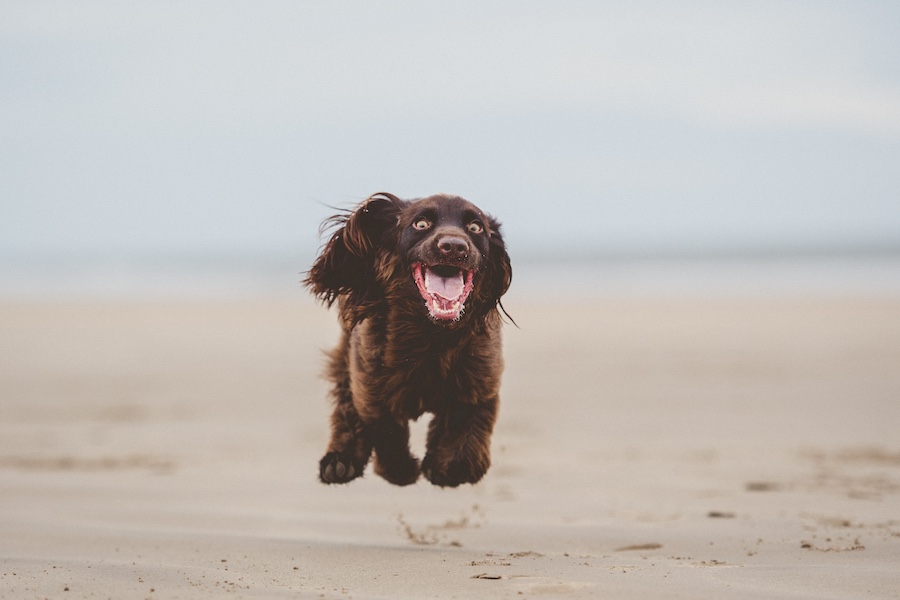
This Cocker Spaniel is running in such a lively and energetic way!
Why do dogs move back?
Dogs may move back in a potentially dangerous, tense or fearful situation.
As in other cases, dog language is composed by many different aspects, which certainly are related to the movements, but also to the look and the position of certain parts of the body, such as the ears or the tail.
Why do dogs “shake off”?
Dog language in this case often linked to a physiological need, that is, to free himself from what is ‘extra’, such as water, dust, dirt…
But the “shaking off” action brings wellbeing to the pet, which is why it can be adopted as a sort of natural anti-stress, because shaking is equivalent to finding composure and getting rid of anxiety… (it would be useful for us as well sometimes, wouldn’t it?).
In the same way, he can “shake off” as a form of self-reassurance. This gesture makes him feel good, that’s why he shakes off when he feels like he wants to recover physical well-being and serenity.

Pets can “shake off” to clean their fur, but also as a “rebalancing” action.
What does it mean when he puts his ears up straight?
In dog language, ears play a very important role and are closely linked to the emotional field.
When dogs put their ears up straight and bring them slightly forward, they show a typical attitude of attention, they’re probably studying the situation or something around them caught their attention. If the pet is very concentrated at that moment, he may tilt his head first to one side and then to the other.
When the pet puts his ears forward, it means that he is attentive, curious, interested. It is no coincidence that even for humans we say that something made us ‘prick up our ears’, that is, it got us curious or alarmed.
Conversely, if he puts his ears back, it can mean that the furry friend feels worried, perplexed and even compliant when he associates it with lying on his back.

Why did this furry friend prick up his ears? What did he see?
Dog language when he goes down with his front legs only
According to Rugaas, when the furry friends lower themselves on their front legs, almost as if they were bowing, this is most likely a position that invites to play.
If the dog in this position has a playful and cheerful attitude, then this is almost certainly the expressed intention. However, sometimes, the dog can lower himself on his front legs without moving, or he can lower himself and immediately get up again with a sudden movement. In this case it can be a calming signal that he sends to another dog or even to other animals, very common if, by chance, he meets horses.
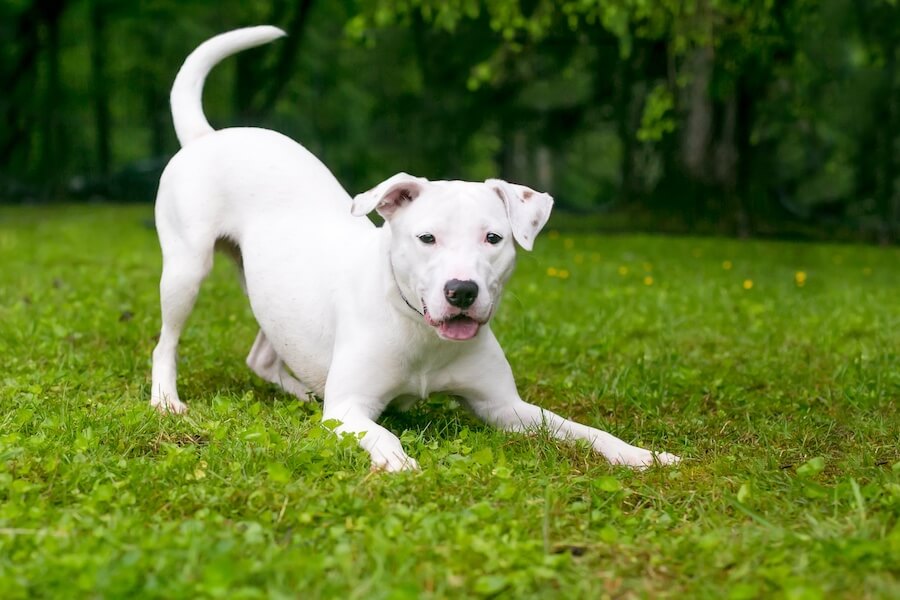
This awesome pet went down with his front legs, he probably can’t wait to play with us!
Why do dogs yawn?
In some positions the dog language may therefore seem clear to us, while in others it may be more ambiguous.
We might think that yawning is among the most understandable ones, because we humans tend to associate this gesture with tiredness or boredom.
According to Turid Rugaas, dogs frequently yawn as a calming signal.
Considering that pets have the mission of pacifying and defusing, it is not uncommon that while we discuss or even argue in the family, dogs sit in a corner and yawn.
This is their way of telling us to stop or making us understand that the current situation is making them stressed. And, in the same way, since we have learned this dog language, if the pet is very agitated or nervous, we can in turn yawn to communicate him this calming signal.

Is this Border Collie very sleepy or does he want to bring some peace among humans?
Dog language in everyday life
As seen, understanding the dog’s gestures is a special adventure, as well as interpreting the dog language and, consequently, acting to satisfy the requests he’s communicating.
The idea that our four-legged hearts almost always want to ‘calm’ a potentially tense or dangerous situation is very encouraging, but once he communicates this to us with his language it is our task to act accordingly, both in the relationships with his peers and with us humans.
For this reason, understanding the dog language is something that we should all strive to do in everyday life, perhaps starting by observing, and then understanding which gestures he most frequently makes.

So much love enclosed in just one look.
The key word is understanding, a wonderful word that can help us make our pet feel better on many occasions. It also helps us live our friendship in a deeper way, strengthening our relationship day after day.
Article written with the consultancy of Chiara Festelli, Dog Trainer.




